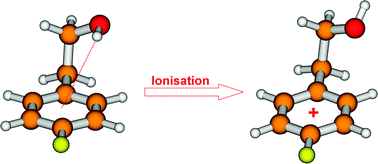Mass analysed threshold ionisation spectroscopy of flexible 2-para-fluorophenylethanol conformers with and without an intramolecular OH⋯π bond
Abstract
The cationic state of the prototype flexible molecule

* Corresponding authors
a
Physikalische und Theoretische Chemie, Technische Universität München, Lichtenbergstr. 4, Garching, Germany
E-mail:
neusser@ch.tum.de
The cationic state of the prototype flexible molecule

 Please wait while we load your content...
Something went wrong. Try again?
Please wait while we load your content...
Something went wrong. Try again?
R. Karaminkov, S. Chervenkov and H. J. Neusser, Phys. Chem. Chem. Phys., 2009, 11, 2249 DOI: 10.1039/B817519E
To request permission to reproduce material from this article, please go to the Copyright Clearance Center request page.
If you are an author contributing to an RSC publication, you do not need to request permission provided correct acknowledgement is given.
If you are the author of this article, you do not need to request permission to reproduce figures and diagrams provided correct acknowledgement is given. If you want to reproduce the whole article in a third-party publication (excluding your thesis/dissertation for which permission is not required) please go to the Copyright Clearance Center request page.
Read more about how to correctly acknowledge RSC content.
 Fetching data from CrossRef.
Fetching data from CrossRef.
This may take some time to load.
Loading related content
